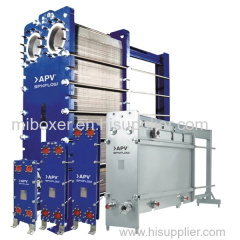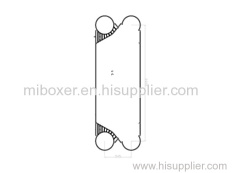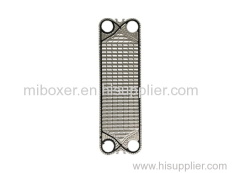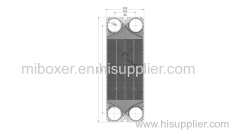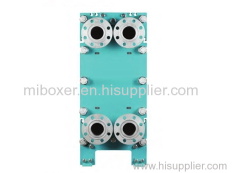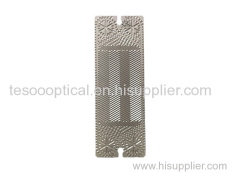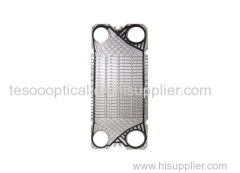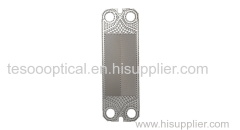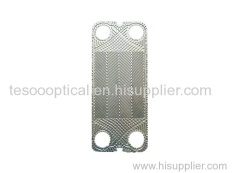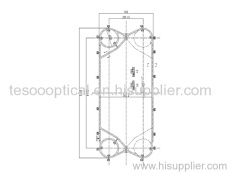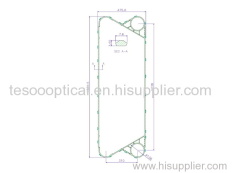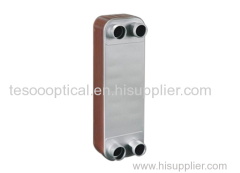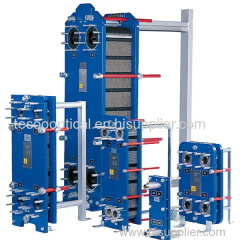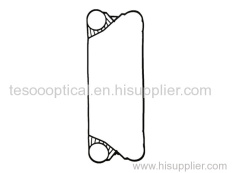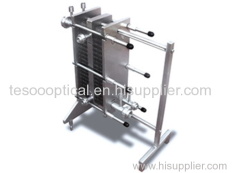
|
China Plate Heat Exchange Co., Ltd
|
Heat Exchanger Plates plateheatexchange
| Price: | 5.0 USD |
| Payment Terms: | T/T |
| Place of Origin: | Beijing, China (Mainland) |
|
|
|
| Add to My Favorites | |
| HiSupplier Escrow |
Product Detail
Heat exchanger plates are the key components in plate heat exchangers.
Heat exchanger plates are the key components in plate heat exchangers. These plates are designed with specialized patterns or corrugations to maximize heat transfer efficiency. They provide a large surface area for heat exchange between fluids, ensuring effective and efficient thermal performance in various industrial applications.
Types of Heat Exchanger Plates
Alfalaval Heat Exchanger Plates
Alfa Laval heat exchanger plates are specifically designed plates used in Alfa Laval plate heat exchangers. These plates are made of high-quality stainless steel or titanium to ensure durability and corrosion resistance.
APV Heat Exchanger Plates
APV heat exchanger plates are specialized plates utilized in APV (Aurora Plate and Vessel) plate heat exchangers. These plates are meticulously engineered to facilitate efficient heat transfer between fluids.
Tranter Heat Exchanger Plates
Tranter plates feature unique patterns, such as chevron or herringbone, which enhance heat transfer efficiency by creating turbulent flow and maximizing the contact surface area.
GEA Heat Exchanger Plates
GEA heat exchanger plates are specifically designed plates used in GEA plate heat exchangers. These plates are made of high-quality materials like stainless steel or titanium and feature unique designs to optimize heat transfer efficiency.
Kelvion Heat Exchanger Plates
Kelvion heat exchanger plates are designed for Kelvion plate heat exchangers. Made from durable materials like stainless steel or titanium, these plates maximize heat transfer efficiency. Kelvion offers a range of plate sizes and configurations to suit different applications.
Sondex Heat Exchanger Plates
Sondex plates feature unique patterns that enhance heat transfer efficiency by creating turbulent flow and maximizing the contact surface area.
ITT Heat Exchanger Plates
ITT plates feature innovative designs that maximize heat transfer efficiency by creating turbulent flow and optimizing surface area contact. They are designed to seamlessly integrate into ITT heat exchanger frames, facilitating easy installation and maintenance.
SWEP Heat Exchanger Plates
SWEP offers a wide range of plate sizes and configurations to meet diverse heat transfer requirements, providing reliable and efficient performance in various industrial applications.
VICARB Heat Exchanger Plates
VICARB plates feature unique designs that facilitate efficient heat transfer by creating turbulent flow and maximizing the contact surface area. They are designed to seamlessly fit into VICARB heat exchanger frames, enabling easy installation and maintenance.
API-Schmidt Heat Exchanger Plates
They are designed to seamlessly fit into API-Schmidt heat exchanger frames, facilitating easy installation and maintenance. API-Schmidt offers a wide range of plate sizes and configurations to meet diverse heat transfer requirements, delivering reliable and efficient performance in various industrial applications.
FUNKE Heat Exchanger Plates
UNKE offers a wide range of plate sizes and configurations to meet various heat transfer requirements, providing reliable and efficient performance in diverse industrial applications.
THERMOWAVE Heat Exchanger Plates
THERMOWAVE specializes in providing plate heat exchangers for a range of industries, including air conditioning, refrigeration, and chemical applications.
HISAKA Heat Exchanger Plates
With a wide range of plate sizes and configurations, HISAKA offers reliable and efficient heat transfer solutions for industrial processes across different sectors.
Mueller Heat Exchanger Plates
Mueller heat exchanger plates are designed for Mueller plate heat exchangers. Made of high-quality materials, they optimize heat transfer efficiency. Mueller provides various plate sizes and configurations to meet different application needs.
FISCHER Heat Exchanger Plates
Fischer heat exchanger plates are exclusively designed for Fischer plate heat exchangers. These plates are crafted using premium materials, maximizing heat transfer efficiency. Fischer offers a diverse range of plate sizes and configurations to suit various applications.
SASAKURA Heat Exchanger Plates
Sasakura heat exchanger plates are designed for Sasakura plate heat exchangers. They are engineered for efficient heat transfer.
LHE Heat Exchanger Plates
LHE heat exchanger plates are specifically designed plates used in LHE plate heat exchangers. These plates optimize heat transfer efficiency and are available in various sizes and configurations to meet different application requirements.
DHP Heat Exchanger Plates
DHP heat exchanger plates are specifically engineered plates used in DHP plate heat exchangers. These plates are crafted from high-quality materials to ensure durability and corrosion resistance.
AGC Heat Exchanger Plates
AGC plates feature innovative designs that optimize heat transfer efficiency, maximizing surface area and creating turbulent flow. AGC offers a range of plate sizes and configurations to meet various heat transfer requirements, delivering reliable and efficient performance in industrial applications.
Armstrong Heat Exchanger Plates
Armstrong heat exchanger plates are specifically designed plates used in Armstrong plate heat exchangers. These plates are made from high-quality materials and feature innovative designs to optimize heat transfer efficiency. Armstrong offers a range of plate sizes and configurations to meet various heat transfer requirements, ensuring reliable performance in industrial applications.
Cipriani Heat Exchanger Plates
Cipriani heat exchanger plates are designed for Cipriani plate heat exchangers. They maximize heat transfer efficiency and are available in different sizes and configurations to meet diverse application needs.
READ MORE
Advantages of Heat Exchanger Plates
01
Thin and Flat Components
Heat exchanger plates are thin and flat components typically made of materials like stainless steel, titanium, or nickel alloys. They are arranged in a stacked configuration, with alternating channels for the two fluids involved in the heat exchange process. The plates are sealed together using gaskets or brazing to ensure that the fluids flow through their respective channels without mixing.
02
Specially Designed Patterns
The plates have specially designed patterns, such as corrugations or chevron-shaped patterns, which serve several purposes. First, these patterns increase the effective heat transfer surface area, allowing for efficient thermal exchange. Second, they create turbulence in the fluid flow, disrupting laminar flow and enhancing heat transfer by promoting better mixing and minimizing the formation of boundary layers. This turbulent flow helps maximize heat transfer rates between the fluids.
03
Plate Material
The choice of plate material is crucial in heat exchanger plate design. It depends on the specific application and the properties of the fluids being processed. Different materials offer varying resistance to corrosion, fouling, and high temperatures, ensuring the plates can withstand the operating conditions.
What Does a Heat Exchanger Plate Do?
A heat exchanger plate is a crucial component in a plate heat exchanger, and its primary function is to facilitate efficient heat transfer between two fluids. The plate acts as a barrier between the fluids while allowing heat to be exchanged between them. Here's a detailed explanation of what a heat exchanger plate does:
Heat Transfer Surface
The plate provides a large surface area for heat exchange to occur between the two fluids. The fluids flow on either side of the plate, with one fluid passing through the channels formed by the plates' corrugations or other specialized patterns. The extensive contact area between the fluids and the plate allows for effective heat transfer.
Turbulent Flow Promotion
The design of the heat exchanger plate, such as the corrugations or chevron-shaped patterns, promotes turbulent flow in the fluid streams. Turbulence disrupts the laminar flow, ensuring thorough mixing of the fluids and minimizing the formation of stagnant boundary layers. Turbulent flow enhances heat transfer efficiency by maintaining a greater temperature gradient across the plate surface.
Separation and Thermal Insulation
The heat exchanger plate separates the two fluids, preventing direct mixing while facilitating the transfer of heat between them. Gaskets or other sealing mechanisms around the edges of the plates ensure fluid separation and prevent leakage. Additionally, the plate and the gaskets provide thermal insulation, minimizing heat loss through conduction between the fluids.



